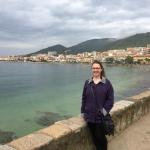Support
Ever since I started learning French in high school, I have been fascinated with the Francophone world and how languages shape our identities. During my time at St. Lawrence, I have taken several courses that have covered colonialism, cultural identities, and power structures. I studied abroad on the Global Francophone program in 2016 which inspired me to continue learning about the Francophone world and return to France for spring 2018.
Something that interested me were France’s overseas departments and their relationship they have with France. Former colonies such as Senegal gained independence from France in the 1960’s, but others, like New Caledonia, remain a part of France. While most of these regions were former French colonies, Corsica, an island in the Mediterranean Sea, was annexed by the French in 1768 and immediately became another region of France- similar to Hawaii for the United States. That made me wonder if Corsica could be considered a colony or not. Having never been to Corsica before, I was also curious to know if the island had a stronger French or Italian influence, and what was the predominant language. I applied for a travel enrichment grant to go to Corsica at the end of my spring semester in Bordeaux, France to learn more about the language, identity and history of the island.
On the first day I flew into Ajaccio, the capital of Corsica, early in the morning. The first thing I noticed was the incredible natural beauty: enormous mountains covered in greenery reaching out to a teal-blue sea. In Ajaccio I went to the Napoleon Bonaparte Museum (Napoleon’s childhood house) and the Napoleon Monument where I learned about Napoleon’s life and his connection to Ajaccio. I noticed that most of the people speaking Corsican on the streets were older, whereas most of the younger generation were speaking in French. Corsican sounds very similar to Italian, which made it difficult two differentiate between the two until I compared them side by side. Many road signs, museums, and public transportation had their content written in both Corsican and French, sometimes Italian too.
The second day I took the train to Corte, the former capital of Corsica, located in the center of the island. While there, I went to the Museum of Corsica where I learned about the history of Corsica and how Corsica is seen a touristic hub for France. Corsica’s preserved natural beauty and their sunny climate has given them the nickname: “Island of Beauty”. There are some independence movements in Corsica that hope to gain independence from France, there was a lot of their graffiti in Corte. That night, I took the train to Bastia, a port city in the north of the island not far from Italy. The following morning, I walked the streets of Bastia and went to the Museum of Bastia where I learned about Corsican art and ancient history. I visited the old and new ports in addition to several churches and cathedrals. The architecture of Bastia felt more Italian than Ajaccio’s did.
The museums I went to helped me learn about the Corsicans, their art, and their culture. Being in Corsica and observing people in the streets along with architecture and food gave me a glimpse into the way the island has been influenced by Italy and France and how they have formed their own unique culture while maintaining the Corsican language. My three days in Corsica were incredible and I am very thankful to the Glitz family for giving me the opportunity to visit and gather some information that I am using for my SYE, it truly was an experience I will never forget.
